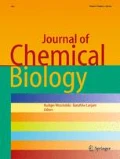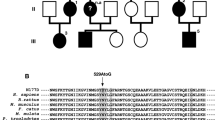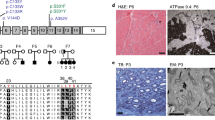Abstract
Axonal degeneration is the final common path in many neurological disorders. Subsets of neuropathies involving the sensory neuron are known as hereditary sensory neuropathies (HSNs). Hereditary sensory neuropathy type I (HSN-I) is the most common subtype of HSN with autosomal dominant inheritance. It is characterized by the progressive degeneration of the dorsal root ganglion (DRG) with clinical symptom onset between the second or third decade of life. Heterozygous mutations in the serine palmitoyltransferase (SPT) long chain subunit 1 (SPTLC1) gene were identified as the pathogenic cause of HSN-I. Ultrastructural analysis of mitochondria from HSN-I patient cells has displayed unique morphological abnormalities that are clustered to the perinucleus where they are wrapped by the endoplasmic reticulum (ER). This investigation defines a small subset of proteins with major alterations in abundance in mitochondria harvested from HSN-I mutant SPTLC1 cells. Using mitochondrial protein isolates from control and patient lymphoblasts, and a combination of 2D gel electrophoresis, immunoblotting and mass spectrometry, we have shown the increased abundance of ubiquinol-cytochrome c reductase core protein 1, an electron transport chain protein, as well as the immunoglobulin, Ig kappa chain C. The regulation of these proteins may provide a new route to understanding the cellular and molecular mechanisms underlying HSN-I.





Similar content being viewed by others
References
Bejaoui K, Wu C, Scheffler MD, Haan G, Ashby P, Wu L, De Jong P, Brown RH Jr (2001) SPTLC1 is mutated in hereditary sensory neuropathy, type 1. Nat Genet 27:261–262
Bozidis P, Williamson CD, Colberg-Poley AM (2007) Isolation of endoplasmic reticulum, mitochondria, and mitochondria-associated membrane fractions from transfected cells and from human cytomegalovirus-infected primary fibroblasts. Curr Protoc Cell Biol. doi:10.1002/0471143030.cb0327s37
Butt RH, Coorssen JR (2005) Postfractionation for enhanced proteomic analyses: routine electrophoretic methods increase the resolution of standard 2D-PAGE. J Proteome Res 4:982–991
Churchward M, Butt RH, Lang J, Hsu K, Coorssen J (2005) Enhanced detergent extraction for analysis of membrane proteomes by two-dimensional gel electrophoresis. Proteome Sci 3:5
Crofts AR (2004) The cytochrome bc1 complex: function in the context of structure. Annu Rev Physiol 66:689–733
Dawkins JL, Hulme DJ, Brahmbhatt SB, Auer-Grumbach M, Nicholson GA (2001) Mutations in SPTLC1, encoding serine palmitoyltransferase, long chain base subunit-1, cause hereditary sensory neuropathy type I. Nat Genet 27:309–312
Dedov V, Dedova I, Merrill A, Nicholson G (2004) Activity of partially inhibited serine palmitoyltransferase is sufficient for normal sphingolipid metabolism and viability of HSN1 patient cells. Biochim Biophys Acta 1688(2):168–175
Drose S, Brandt U, WittigI (2014) Mitochondrial respiratory chain complexes as sources and targets of thiol-based redox-regulation. Biochim Biophys Acta 1844(8):1344–1354. doi:10.1016/j.bbapap.2014.02.006
Duffy LM, Chapman AL, Shaw PJ, Grierson AJ (2011) Review: the role of mitochondria in the pathogenesis of amyotrophic lateral sclerosis. Neuropathol Appl Neurobiol 37:336–352
Dyck PJ, Thomas PK (2005) Dyck: peripheral neuropathy, 4th edn. Mosby Elsevier, Philadelphia
Gauci VJ, Padula MP, Coorssen JR (2013) Coomassie blue staining for high sensitivity gel-based proteomics. J Proteomics 90:96–106
Hanada K (2003) Serine palmitoyltransferase, a key enzyme of sphingolipid metabolism. Biochim Biophys Acta 1632:16–30
Hollenbeck PJ, Saxton WM (2005) The axonal transport of mitochondria. J Cell Sci 118:5411–5419
Hornemann T, Richard S, Rutti M, Wei Y, Von-Eckardstein A (2006) Cloning and initial characterization of a new subunit for mammalian serine-palmitoyltransferase. J Biol Chem 281(49):37275–37281
Hutchinson AT, Ramsland PA, Jones DR, Agostino M, Lund ME, Jennings CV, Bockhorni V, Yuriev E, Edmundson AB, Raison RL (2010) Free Ig light chains interact with sphingomyelin and are found on the surface of myeloma plasma cells in an aggregated form. J Immunol 185:4179–4188
Kindt TJ, Goldsby RA, Osborne BA, Kuby J (2007) Kuby immunology. W.H. Freeman, New York
Kwong JQ, Beal MF, Manfredi G (2006) The role of mitochondria in inherited neurodegenerative diseases. J Neurochem 97:1659–1675
Mandon EC, Ehses I, Rother J, Van Echten G, Sandhoff K (1992) Subcellular localization and membrane topology of serine palmitoyltransferase, 3-dehydrosphinganine reductase, and sphinganine N-acyltransferase in mouse liver. J Biol Chem 267:11144–11148
Manfredi G, Beal MF (2000) The role of mitochondria in the pathogenesis of neurodegenerative diseases. Brain Pathol 10:462–472
Marshall LL, Stimpson SE, Hyland RA, Coorssen JR, Myers SJ (2014) Increased lipid droplet accumulation associated with a peripheral sensory neuropathy. J Chem Biol 7:67–76
McCampbell A, Truong D, Broom D, Allchorne A, Gable K, Cutler RG, Mattson M, Woolf C, Frosch M, Harmon J, Dunn T, Brown R (2005) Mutant SPTLC1 dominantly inhibits serine palmitoyltransferase activity in vivo and confers an age-dependent neuropathy. Hum Mol Genet 14(22):3507–3521
Miller KE, Sheets MP (2004) Axonal mitochondrial transport and potential are correlated. J Cell Sci 117:2791–2804
Myers S, Malladi C, Hyland R, Bautista T, Boadle R, Robinson P, Nicholson G (2014) Mutantions in the SPTLC1 protein cause mitochondrial structual abnormalisites and endoplasmic reticulum stress in lymphoblasts. DNA Cell Biol 33(7):399–407
Vaseva AV, Moll UM (2013) Identification of p53 in mitochondria. Methods Mol Biol 962:75–84
Verhoeven K, Timmerman V, Mauko B, Pieber TR, De Jonghe P, Auer-Grumbach M (2006) Recent advances in hereditary sensory and autonomic neuropathies. Curr Opin Neurol 19:474–480
Wei J, Yerokun Y, Liepelt M, Momin A, Wang E, Hanada K, Merril AH Jr. (2007) 2–1 Serine palmitoyltransferase. Sphingolipid Biology. Springer, Japan, p 25–27
Wright EP, Partridge MA, Padula MP, Gauci VJ, Malladi CS, Coorssen JR (2014) Top-down proteomics: enhancing 2D gel electrophoresis from tissue processing to high-sensitivity protein detection. Proteomics 14:872–889
Yamamoto K, Yagi H, Lee YH, Kardos J, Hagihara Y, Naiki H, Goto Y (2010) The amyloid fibrils of the constant domain of immunoglobulin light chain. FEBS Lett 584:3348–3353
Yard B, Carter L, Johnson K, Overton I, Dorward M, Liu H, McMahon S, Oke M, Puech D, Barton G, Naismith J, Campopiano D (2007) The structure of serine palmitoyltransferase; gateway to sphingolipid biosynthesis. J Mol Biol 370(5):870–886
Yasuda S, Nishijima M, Hanada K (2003) Localization, topology, and function of the LCB1 subunit of serine palmitoyltransferase in mammalian cells. J Biol Chem 278:4176–4183
Zhu Y, Li M, Wang X, Jin H, Liu S, Xu J, Chen Q (2012) Caspase cleavage of cytochrome c1 disrupts mitochondrial function and enhances cytochrome c release. Cell Res 22:127–141
Acknowledgments
We are grateful to Prof. Garth Nicholson (Molecular Medicine Laboratory and Northcott Neuroscience Laboratory Anzac Research Institute, Sydney) for providing all EBV-transformed lymphoblast lines used in this study. SES was supported by APA Research Scholarship and the UWS School of Science and Health Postgraduate research fund. SJM notes the continuing support of an anonymous private foundation. JRC acknowledges the support of the UWS School of Medicine.
Author information
Authors and Affiliations
Corresponding authors
Rights and permissions
About this article
Cite this article
Stimpson, S.E., Coorssen, J.R. & Myers, S.J. Mitochondrial protein alterations in a familial peripheral neuropathy caused by the V144D amino acid mutation in the sphingolipid protein, SPTLC1. J Chem Biol 8, 25–35 (2015). https://doi.org/10.1007/s12154-014-0125-x
Received:
Accepted:
Published:
Issue Date:
DOI: https://doi.org/10.1007/s12154-014-0125-x




